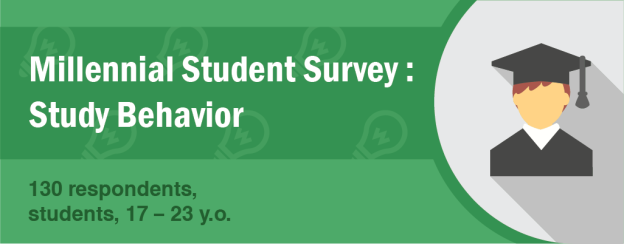Millennial Generation has grown up being able to easily access and gain any information they want to know. Therefore, the teaching methods at school and college have been shifting as millennials were raised in an era where new media and technology became main tools in everyday life. With the internet and all, we assume that there is also a shifting in learning preferences, behaviors, and attitudes of students. Therefore, we would like to know further how study behaviors amongst millennials, particularly in Indonesia, as a developing country with high rate of internet penetration. Jakpat recently conducted a survey regarding to study behavior of the Indonesian millennial students. This survey involved 130 students across Indonesia in a range of ages from 17 to 23 year-old. First of all, we found that most (84%) of Indonesian millennial students are still taking notes during class. Despite today’s advanced gadgets such as tablet, laptop, voice and video recording; apparently most of them (72%) are taking notes with pen and book.
One of teaching methods that teachers and lecturers apply to millennials is presentation, in which students have to do an independent presentation for a certain topic, either individually or in a group. Almost all (98%) of Indonesian millennial student admitted that their teachers and/or lecturers have ordered them to do a presentation in class. Many of them (62%) stated that this method is effective to learn a certain topic. Further, when asked about the source of study materials, most of them (80%) answered that they got it from both the internet and printed textbooks. This indicates that though they are able to Google any information they want and need to know, millennial students are still considering looking up to the printed books.
In regard to the habit of buying and reading books, more than half (56%) of Indonesian millennial students admitted that they usually buy about one to five books in a month. Surprisingly, there are 40% of them who admitted that they usually don’t buy any book at all in a month. Concurrently, many of them (60%) are buying printed book instead of e-book, and there are 32% of them who buy both of printed book and e-book. Meanwhile, many (65%) of Indonesian millennial students stated that they usually read only one to three books in a month. Also, there are only 16% of them who usually read about four to six books in a month. Furthermore, more than half of them (54%) stated that they are reading both of printed book and e-book. These findings indicate that millennial students are creatively looking for alternative ways to read a book rather than buying one, perhaps through borrowing printed book from a friend or free downloading e-book from the website. However, this still needs further research.
About the learning method, apparently many (63%) of Indonesian millennial students admitted that printed book is still way more comfortable to read than e-book. Meanwhile, there are 31% of them who feel comfortable in learning through both printed book and e-book. Furthermore, when asked about which learning method they prefer, many of them (65%) stated that they prefer a combination of both theoretical and practice learning, or so called as praxis method. More than half of them (53%) think that praxis method is the most effective way of learning rather than to learn only theoretical or only practice. This indicates that millennial students prefer active learning methods rather than the passive ones.
Apparently, their learning environment has a quite significant impact on millennial students study behavior. Many of them (70%) admitted that they often study in group with their peers. Furthermore, more than half of them (59%) think that doing their task in a working group is more effective than doing it individually. However, more than half of them (58%) still aren’t used to have discussion with their teachers and/or lecturers. This indicates that somehow, though they prefer a variety of active learning methods, Indonesian millennial students apparently still got their individuality in some learning areas.
For more detail you can download XLS report at the button below (bahasa). JAKPAT report consists of 3 parts which are 1) Respondent Profile, 2) Crosstabulation for each question and 3) Raw Data. Respondent profile shows you demographic profiles ( gender,age range, location by province, and monthly spending). Cross tabulation enables you to define different demographicsegment preference on each answer.
Result in Bahasa
You can also download PDF here:
or Get A Sales Quote by filling this form or Call to +622745015293















